Related Research Articles
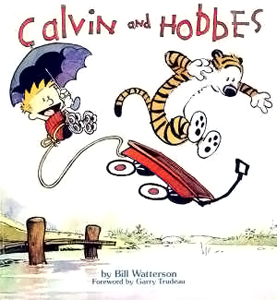
Calvin and Hobbes is a daily American comic strip created by cartoonist Bill Watterson that was syndicated from November 18, 1985, to December 31, 1995. Commonly cited as "the last great newspaper comic", Calvin and Hobbes has enjoyed broad and enduring popularity, influence, and academic and philosophical interest.

A comic book, also called comicbook, comic magazine or simply comic, is a publication that consists of comics art in the form of sequential juxtaposed panels that represent individual scenes. Panels are often accompanied by descriptive prose and written narrative, usually, dialogue contained in word balloons emblematic of the comics art form.

Flash Gordon is the protagonist of a space adventure comic strip created and originally drawn by Alex Raymond. First published January 7, 1934, the strip was inspired by, and created to compete with, the already established Buck Rogers adventure strip.

A graphic novel is a long-form, fictional work of sequential art. The term graphic novel is often applied broadly, including fiction, non-fiction, and anthologized work, though this practice is highly contested by comics scholars and industry professionals. It is, at least in the United States, typically distinct from the term comic book, which is generally used for comics periodicals and trade paperbacks.

Guy Berkeley "Berke" Breathed is an American cartoonist, children's book author, director, and screenwriter, known for his comic strips Bloom County, Outland, and Opus. Bloom County earned Breathed the Pulitzer Prize for Editorial Cartooning in 1987.

Skaro is a fictional planet in the British science fiction television series Doctor Who. It was created by the writer Terry Nation as the home planet of the Daleks.
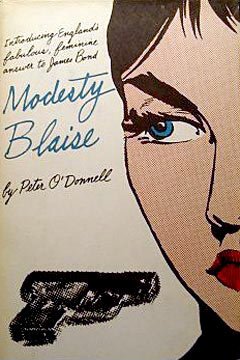
Modesty Blaise is a British comic strip featuring a fictional character of the same name, created by author Peter O'Donnell and illustrator Jim Holdaway in 1963. The strip follows Modesty Blaise, an exceptional young woman with many talents and a criminal past, and her trusty sidekick Willie Garvin. It was adapted into films in 1966, 1982, and 2003, and from 1965 onwards, 11 novels and two short-story collections were written.

The Phantom is an American adventure comic strip, first published by Lee Falk in February 1936. The main character, the Phantom, is a fictional costumed crime-fighter who operates from the fictional African country of Bangalla. The character has been adapted for television, film and video games.

The Ballad of Halo Jones is a science fiction comic strip written by Alan Moore and drawn by Ian Gibson, with lettering by Steve Potter and Richard Starkings.
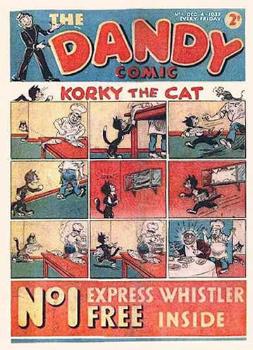
The Dandy was a Scottish children's comic magazine published by the Dundee based publisher DC Thomson. The first issue was printed in December 1937, making it the world's third-longest running comic, after Il Giornalino and Detective Comics. From August 2007 until October 2010, it was rebranded as Dandy Xtreme.

An American comic book is a thin periodical originating in the United States, on average 32 pages, containing comics. While the form originated in 1933, American comic books first gained popularity after the 1938 publication of Action Comics, which included the debut of the superhero Superman. This was followed by a superhero boom that lasted until the end of World War II. After the war, while superheroes were marginalized, the comic book industry rapidly expanded and genres such as horror, crime, science fiction and romance became popular. The 1950s saw a gradual decline, due to a shift away from print media in the wake of television and the impact of the Comics Code Authority. The late 1950s and the 1960s saw a superhero revival and superheroes remained the dominant character archetype throughout the late 20th century into the 21st century.
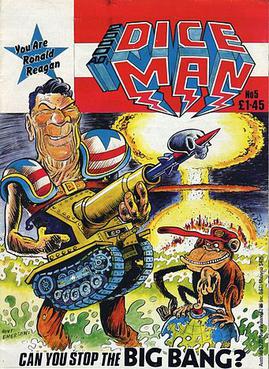
Hunt Emerson is an English cartoonist. He was closely involved with the Birmingham Arts Lab of the mid-to-late 1970s, and with the British underground comics scene of the 1970s and 1980s. His many comic strips and graphic novels have been translated into numerous languages.
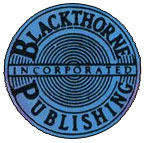
Blackthorne Publishing, Inc. was a comic book publisher that flourished from 1986–1989. They were notable for the Blackthorne 3-D Series, their reprint titles of classic comic strips like Dick Tracy, and their licensed products. Blackthorne achieved its greatest sales and financial success with their licensed 3-D comics adaptations of the California Raisins, but the financial loss suffered by the failure of their 3-D adaptation of Michael Jackson's film Moonwalker was a major contributor to the publisher's downfall.
The Grand Comics Database (GCD) is an Internet-based project to build a database of comic book information through user contributions. The GCD project catalogues information on creator credits, story details, reprints, and other information useful to the comic book reader, comic collector, fan, and scholar. The GCD is a 501(c)(3) nonprofit organization incorporated in Arkansas.

Ricardo Siri, better known by the name Liniers, is an Argentine cartoonist.
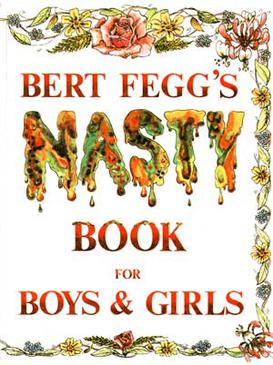
Bert Fegg's Nasty Book for Boys And Girls is a humorous book first published by Methuen in 1974 which purports to have been written by a psychopathic character, Dr. Fegg. In fact, the book is the work of Terry Jones and Michael Palin, who adapted a range of material from scripts written for the television comedy series, Monty Python's Flying Circus. Some material was later used in the duo's later TV series, Ripping Yarns (1975–78). The first edition was sold bearing a sticker on the front cover which read "A Monty Python Educational Product".

Fred Hembeck is an American cartoonist best known for his parodies of characters from major American comic book publishers. His work has frequently been published by the firms whose characters he spoofs. His characters are always drawn with curlicues at the elbows and knees. He often portrays himself as a character in his own work, in the role of "interviewer" of various comic book characters. Interviewer Daniel Best has said of his work, "If you take your comic books seriously, and think that those characters are real, then you're probably not a fan of Hembeck."
Where's Wally? is a British series of children's puzzle books created by English illustrator Martin Handford. The books consist of a series of detailed double-page spread illustrations depicting dozens or more people doing a variety of amusing things at a given location. Readers are challenged to find a character named Wally hidden in the group.

Bookbinding is the process of building a book, usually in codex format, from an ordered stack of paper sheets with one's hands and tools, or in modern publishing, by automated processes. Firstly, one binds the sheets of papers along an edge with a thick needle and strong thread. One can also use loose-leaf rings, binding posts, twin-loop spine coils, plastic spiral coils, and plastic spine combs, but they last for a shorter time. Next, one encloses the bound stack of paper in a cover. Finally, one places an attractive cover onto the boards, and features the publisher's information and artistic decorations.
Superman: The Complete Comic Strips 1939-1966 is an unofficial umbrella name for the six following titles: Superman: The Golden Age Dailies, Superman: The Golden Age Sundays; Superman: The Atomic Age Dailies, Superman: The Atomic Age Sundays; Superman: The Silver Age Dailies and Superman: The Silver Age Sundays, all published by The Library of American Comics. These six series of books collects the complete run of the American comic strip Superman by DC Comics, which was originally distributed in newspapers by the McClure Syndicate between 1939 and 1966.
References
- ↑ Simester, Andrew (2021). Fundamentals of Criminal Law: Responsibility, Culpability, and Wrongdoing. Oxford University Press. p. 45. ISBN 978-0-19-885314-5.